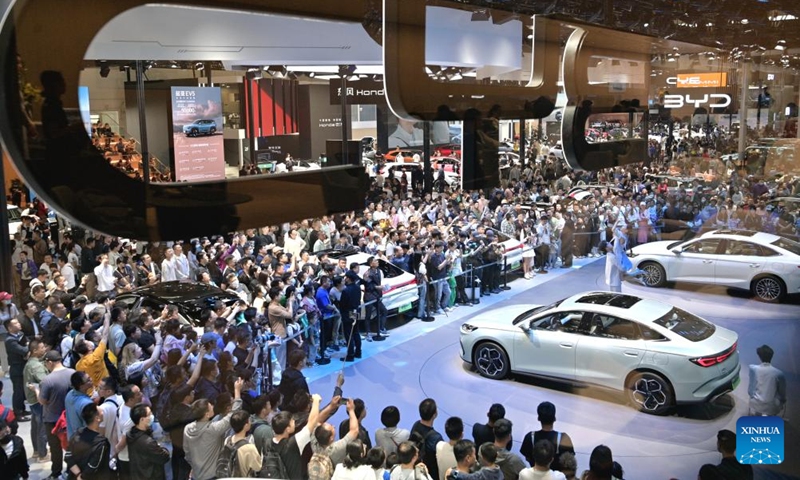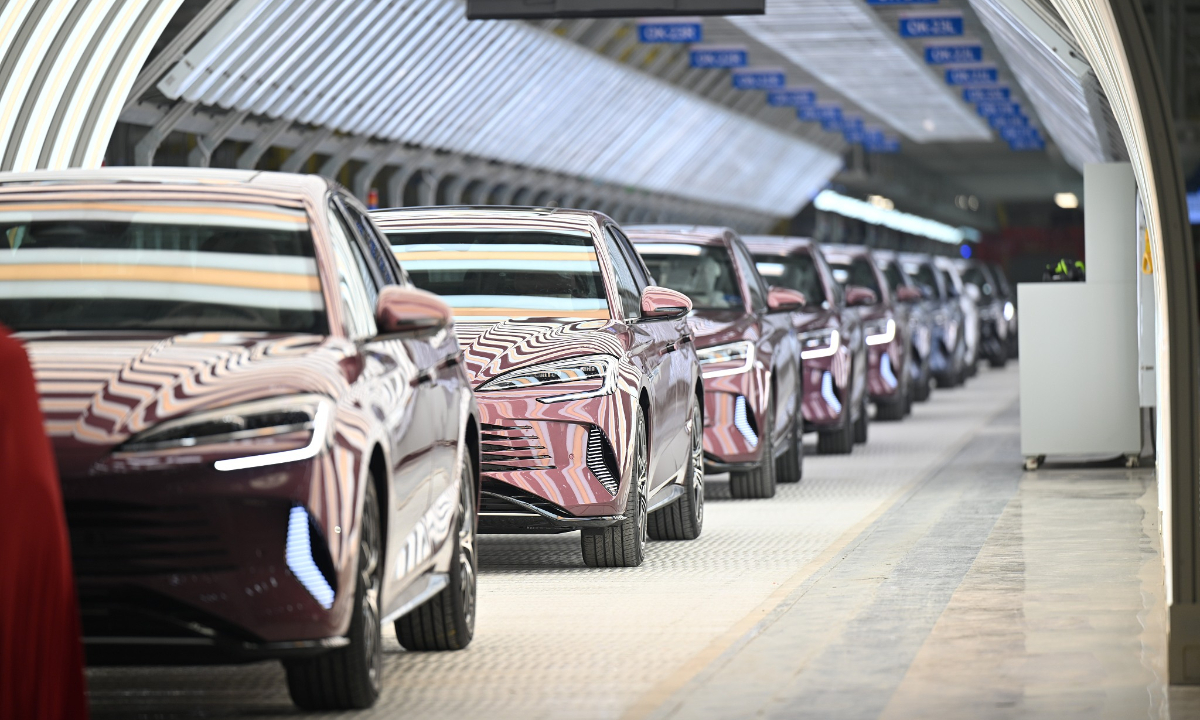Decipher China's green success: competitiveness of Chinese EV industry comes from competition, not subsidies: analysts
Competition, industrial cluster, entrepreneurship drive China’s EV growth

Visitors are seen at the exhibition area of Chinese NEV manufacturer BYD during the 2024 Beijing International Automotive Exhibition in Beijing, capital of China, May 4, 2024. The exhibition closed on Saturday. Photo: Xinhua
Editor's Note:As China's new-energy industries rise to global prominence, US officials have started a smear campaign based on false "overcapacity" claims. The rise of China's new-energy industries is due to innovation, rather than subsidies, and is beneficial for the world, instead of posing threats to other countries. To illustrate this, the Global Times is publishing a multi-part series under the theme of "New Energy, New Opportunities." This story focuses on how the Chinese electric vehicles (EV) industry draws its competitiveness from competition, debunking the groundless narrative that Chinese EV industry's strengths came from government subsidies.
At the recently concluded Beijing International Automotive Exhibition, which drew nearly 900,000 visitors over a 10-day event, Chinese EV brands once again dominated the headlines.
Some 28,000 foreigners were reportedly on the scene, with many taking profound interest in Chinese EV brands to study the models and try to decipher the reasons behind the popularity of Chinese brands.
On account of rising smears on China's green exports "overcapacity," Chinese analysts and industry insiders pointed out that the competitiveness of Chinese EV industry comes from fierce competition, the advantage of industrial cluster and entrepreneurship.
There is no "overcapacity," as the issue of industry capacity will be balanced by the market's invisible hand given the fierce competition existed in the Chinese market, the fact that Chinese automakers are not selling their EVs at prices lower than those billed at the home market and the global gap for more EVs to realize its green development goals, analysts noted.
Industrial cluster
There are several aspects of the strengths of the Chinese EV industries, which produce about 60 percent of the world's EVs, but none are associated with subsidies, analysts noted.
The rising momentum of Chinese EV is in part fueled by the country's investment into its surrounding industries, experts noted, with the number of companies spanning the whole EV industrial and supply chain totaling over one million.
Hefei, East China's Anhui Province, has in recent years built itself into an assembly center of NEVs, with a concentration of upper stream and lower stream suppliers providing the display panel, chips, batteries and artificial intelligence applications needed for building NEVs in a cost-effective way.
In Changzhou, East China's Jiangsu Province, the local industry is closely focused around the manufacturing of power batteries. In fact, the city has 31 out of 32 major segments in the making of batteries, which means 97 percent of the total supply chain spectrum resides in the city, according to a Xinhua News Agency report in April, citing the city government.
The city has more than 30 leading companies in national and global division of labor focused on the manufacturing of electrodes, separators and electrolytes - key parts in making batteries - with an annual industrial output of over 170 billion yuan ($24.02 billion).
Qin Lihong, co-founder of Chinese EV maker Nio, told the Global Times that China's advantage in talent in the EV space is another reason. Nio has factories in Hefei.
"To develop large number of applications used in EVs requires huge amount of man power and energy and China happens to be the place in the world with the most talents skilled in application research & development (R&D)," said Qin.
"To develop a particular type of motor may need 100,000 man hours, and the West's per unit cost of R&D in EV is not in the same league with that of China. The resources of EV R&D are agglomerating toward China," Qin said.
The allocation of resources has meant Chinese EV brands are better positioned to roll out their models in a cost competitive way that their global peers could not, Chinese analysts said.
The Chinese government provides no subsidies for the exports of EVs, rending the accusation of "subsidy" groundless, Cao Heping, an economist at Peking University, told the Global Times. "The accusation is further debunked as the world actually faces a shortage, rather than excess, of EVs in its green transition."
Cao said the West has no legal nor logical ground to ask China to downsize one of its globally competitive industries, which are the result of decades of strategic vision and investment and daring undertakings. "Resolving any global imbalance of resources can be only achieved through dialogue and governance, not a unilateral smear campaign."
As a matter of fact, global auto giant such as Volkswagen is increasing their investment in cities like Hefei, to hitch a ride on China's industrial cluster.
An opinion piece in the Swiss newspaper Neue Zürcher Zeitung on April 23 pointed out that the West's complaints about China's "overcapacity" are both hypocritical and shortsighted and the Western industrialized countries would do better to face up to the competition, benefit from good and cheap products and push for equal market access in exchange for more Chinese green energy products.
The opinion piece analyzed related data, concluding that during the period from 2023 to March 2024, China's subsidies designated for industries related to strategic competitiveness stood at $42 billion, much lower than that of the US, which earmarked $222 billion of funds during the same period.
China's vehicle market got off to a good start in the first quarter of 2024, and NEV exports reached 307,000 units in the period, up 23.8 percent year-on-year, according to China Association of Automobile Manufacturers.
In 2023, China's NEV exports totaled 1.2 million with an annual growth of 77.6 percent.
Relentless entrepreneurship
Chinese analysts pointed out that Chinese EV companies also draw their competitiveness from their relentless pursuit in innovation, despite the fact that the new-energy industry being a high-risk area, and contributed to the global transition toward green development by making NEVs cheaper and more popular around the world.
It is the entrepreneurial spirit that have formed a part of the engine driving the Chinese EV industry ahead, analysts said.
Xiaomi CEO Lei Jun, in a recent interview with state broadcaster CCTV, revealed that the company has thrown in nearly half of its total value, at some $10 billion, into the EV-making adventure to make its SU7, only to bet on a 10 percent success rate.
Lü Xiang, research fellow at the Chinese Academy of Social Sciences, told the Global Times on Monday that even as Xiaomi's initial start with its SU7 is beyond expectation in terms of sales, there is no telling in the company's eventual success in the fiercely competitive domestic market.
With Xiaomi's entry into the EV game, companies such as Tesla and Li Auto has announced cut in their offerings.
Lei said he is not afraid of price wars and is prepared to take losses but aims to become the world's top five EV players in the long-run.




